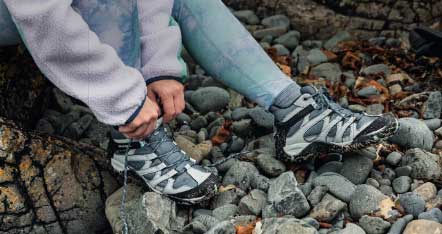Walking Poles Buying Guide
Walking Poles are a mainstay in many walkers’ kits, and for good reason. Walking Poles can greatly reduce the fatigue of walking and offer a full-body workout with every use, as well as providing stability and pain relief to those who struggle with joint and muscle pains. Here’s our full guide to what to look for when choosing your next pair of Walking Poles...
Support
Perhaps the most obvious benefit of Walking Poles is the support they provide to those suffering pain and discomfort in their ankles, knees, or hips - particularly on long or strenuous walks. Walking Poles work by distributing the strain usually placed on these joints around the body so the joint is under less pressure.
Fun Fact: On average, each pole plant removes around 3% - 5% of the impact of that step!
Safety
Walking Poles are an excellent safety measure for all walkers and hikers. Excellent for providing stability on uneven, downhill, or slippery terrain, and great for judging the depths of potential obstacles that you can’t see very well, like streams or snow - they are ideal for use on all walks and trails - no matter how mundane or extreme they may seem.
Propulsion
Using Walking Poles to push off from the ground is a great way to increase your speed and turn your walk into a full-body workout. Engaging your shoulders and arms contributes to excellent upper body strength, whilst distributing the weight of your load across the whole body is a great calorie-burning exercise, especially when wearing a heavy pack.
What To Look For When Buying Your Walking Poles
Telescopic vs Folding Poles
Folding Walking Poles - the ideal choice if weight and packability are your main priorities. Foldable Walking Poles are extra lightweight and fit inside your rucksack instead of attaching to the outside, making them ideal for multi-day treks.
Telescopic Walking Poles - A more durable option, Telescopic Walking Poles are a the ideal choice for more everyday one-day adventures.
Shock Absorbers
Shock-absorbing Walking Poles reduce impact even more than regular versions and are the ideal choice for those suffering from previous joint injuries, strain, or weakness or for more challenging downhill descents.
Handle Material
Different handle materials can bring different individual benefits:
Cork: The most common material and the most environmentally friendly option, perfect for hot weather as it wicks sweat away from your hands and moulds to the shape of your hands.
Rubber: Great for insulating your hands and absorbing vibrations but can be a problem in summer as sweaty hands can cause rubbing and blistering.
Shaft Material
Walking Poles are often made from aluminium or carbon. As with Telescopic vs. Folding poles, the lighter option tends to be the less durable:
Carbon: Offers marginal weight savings but can be susceptible to cracking with extended or rough use.
Aluminium: Offers incredible vibration absorption and extended durability over time.
Locking Mechanism
Walking Poles usually have either a clamp or twist-to-lock mechanism. Both are reliable, but clamps are often easier to operate while wearing gloves.
Adjusting To The Right Length
Walking Poles usually have two adjustable sections. For stability, we recommend extending both parts equally. The correct length should create a 90-degree angle at your elbows when you hold the pole in front of you. When walking uphill, you should shorten the poles by 5-10cm and lengthen them by 5-10cm when walking downhill for the best possible support.
Learn more about Walking Poles with a in-store demonstration from our expert Natalya from Cotswold Outdoor Horsham:
Discover Your Perfect Walking Poles Today
Related articles

Let us know you agree to cookies
We use marketing, analytical and functional cookies as well as similar technologies to give you the best experience. Third parties, including social media platforms, often place tracking cookies on our site to show you personalised adverts outside of our website.
We store your cookie preferences for two years and you can edit your preferences via ‘manage cookies’ or through the cookie policy at the bottom of every page. For more information, please see our cookie policy.







